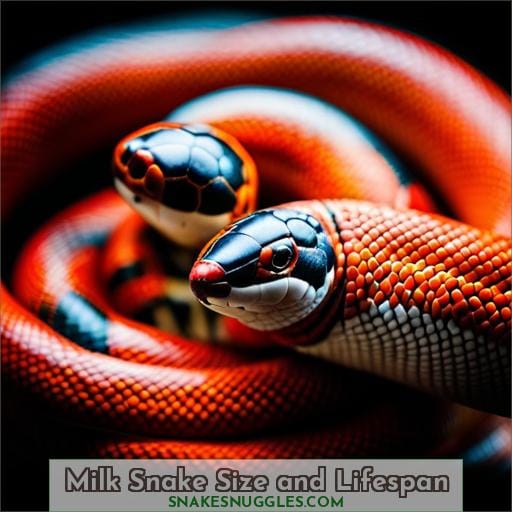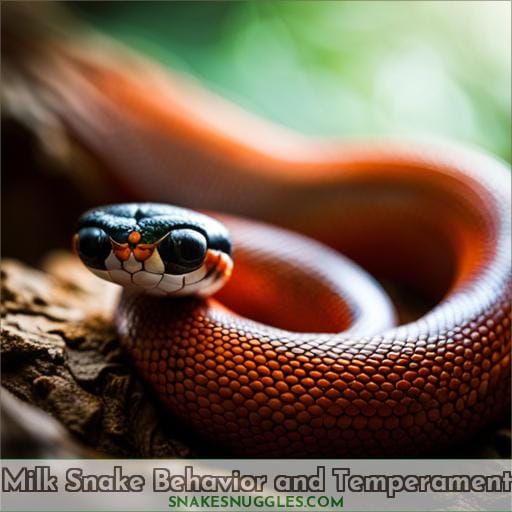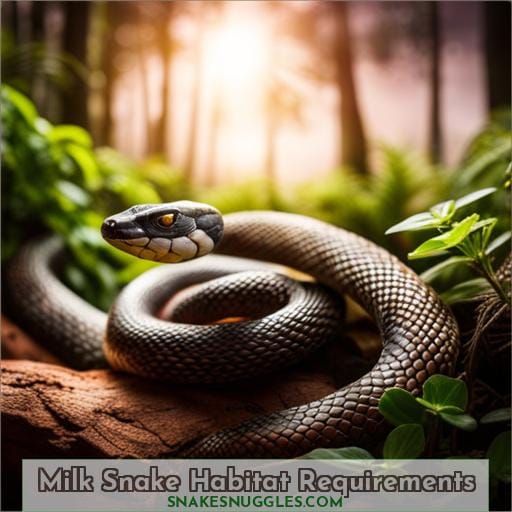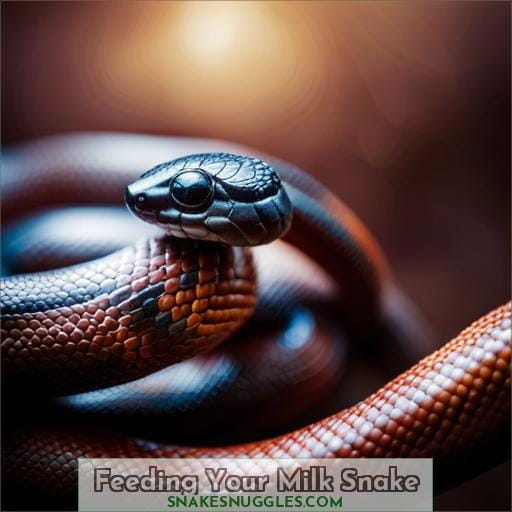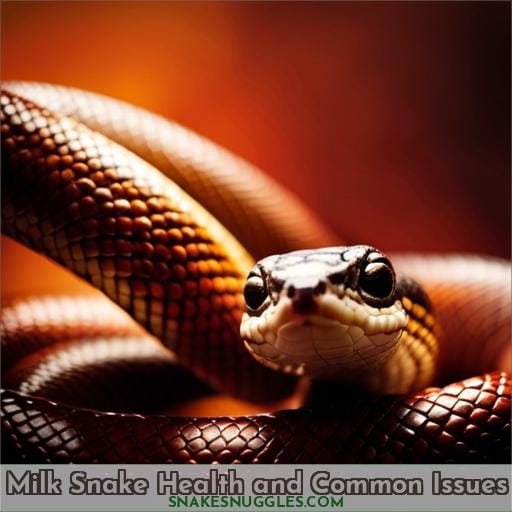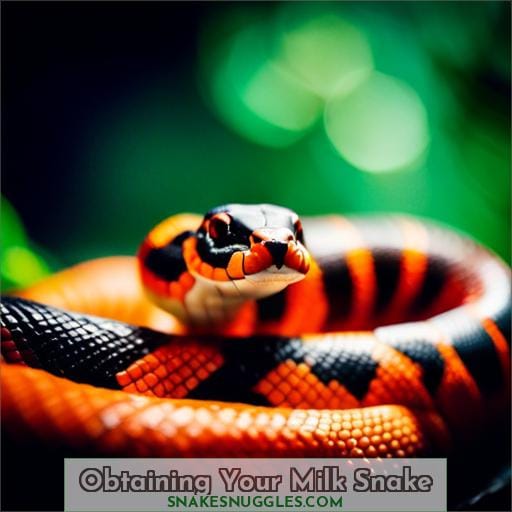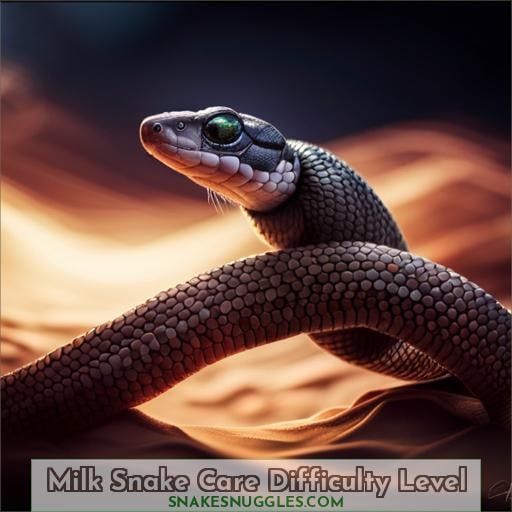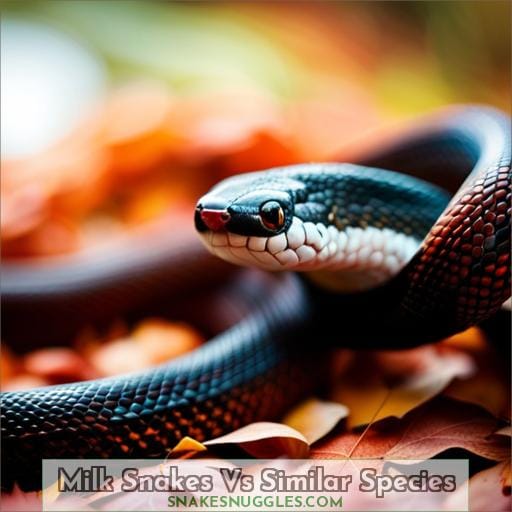This site is supported by our readers. We may earn a commission, at no cost to you, if you purchase through links.
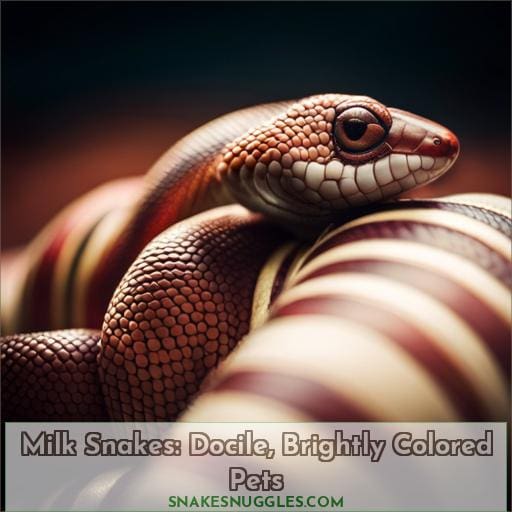
Legend tells of milk snakes crawling into barns to curl up by cows and slurp milk from their udders. That myth belies a gentle docility that makes milk snakes a perfect pet. Their brightly banded scales delight the eye while their mild manners charm the keeper.
Easy to handle, these snakes reward their caretakers with beauty and companionship.
Table Of Contents
- Key Takeaways
- Why Choose a Milk Snake?
- Milk Snake Species and Appearance
- Milk Snake Size and Lifespan
- Milk Snake Behavior and Temperament
- Milk Snake Habitat Requirements
- Feeding Your Milk Snake
- Milk Snake Health and Common Issues
- Obtaining Your Milk Snake
- Milk Snake Care Difficulty Level
- Milk Snakes Vs Similar Species
- Frequently Asked Questions (FAQs)
- Conclusion
Key Takeaways
- Milk snakes have calm, docile temperaments and are easy to handle, making them good pets for beginners and experienced reptile owners alike.
- Proper husbandry and enclosure setup are important for milk snakes to thrive, including appropriate substrate, hides, temperature and lighting needs, water, and regular cleaning.
- Milk snakes have relatively simple care needs like gentle handling techniques and weekly feedings of thawed, pre-killed rodents.
- With proper care and husbandry, milk snakes can live 12+ years. Their health should be closely monitored and veterinary care sought if signs of illness arise.
Why Choose a Milk Snake?
When looking for a pet snake, milk snakes make an excellent choice.
These docile, brightly colored constrictors are a hardy, low-maintenance reptile that can make for a rewarding companion.
With their calm demeanor and modest care requirements, milk snakes have much to offer both beginner and expert herpetoculturists.
Docile Pet Snake
You’re making a great choice with the milk snake as a pet reptile due to its typically docile temperament. These snakes rarely bite or strike, and most can be gently handled after proper acclimation.
Start by briefly handling the snake daily, then gradually increase handling time as the snake seems comfortable.
Provide opportunities for climbing, exploring, and burrowing to keep the snake active and engaged.
Use feeding tongs initially until the snake reliably takes thawed, pre-killed rodents from your hand without mistaking your fingers for food.
The milk snake’s vibrant patterns, peaceful temperament, and manageable size make it an exceptional pet reptile for both novice and expert herpetoculturists.
Low Maintenance Reptile
Moreover, milk snakes make fantastic starter pets as they’re quite hardy and don’t require complex care.
As colorful companions, their simple terrarium setups, feeding habits, and handling tips make them shine as low-maintenance reptiles.
Their mimicry mechanisms also intrigue herpetologists worldwide.
Handling Tips:
- Gentle
- Persistent
- Support body
- Limit stress
Terrarium Setups:
- Substrate
- Hide box
- Water dish
- Thermal gradient
Feeding Habits:
- Rodents
- Appropriate sized
- 1-2 times weekly
- Thawed frozen
Brightly Colored Constrictor
You’ll often admire the brightly colored bands and blotches of milk snakes, nonvenomous constrictors native to North and South America.
Red bands, yellow saddles, black rings.
Mimic venomous coral snakes as defense.
Gentle handling lets enjoy coloration.
Many subspecies with unique patterns.
Milk Snake Species and Appearance
You have several milk snake varieties to choose from. They vary in size, coloration, temperament, and care requirements.
The eastern milk snake is a popular choice, with its gray and reddish-brown coloring and spotted pattern. You’ll also find brightly-colored varieties like the Honduran milk snake, with its wide red, black, and orange-yellow bands.
When selecting your milk snake, consider adult size, as some grow over 6 feet long while others stay under 2 feet.
| Subspecies | Adult Size | Coloration | Temperament |
|---|---|---|---|
| Eastern | 2-4 feet | Gray, reddish-brown spots | Docile |
| Honduran | 4-5 feet | Red, black, orange-yellow bands | Can be nervous |
| Louisiana | 2 feet | Red bands twice as wide as black & white | Docile |
| Central Plains | 2 feet | Red, black, yellowish white | Docile |
| Black | 4-6 feet | Color changes from red, black & white to solid black | Can be nervous |
Milk Snake Size and Lifespan
You’re looking at snakes ranging from 20 to 60 inches long with some varieties growing up to seven feet.
Captive-born and raised Milksnakes can live at least twelve years, depending on species, genetics, and quality of care.
- Average adult length between 2 to 5 feet (20 to 60 inches), varying greatly by subspecies.
- Maximum recorded lengths up to 84 inches (7 feet).
- Lifespan 12+ years with proper husbandry.
- Growth rate depends on genetics and feeding regimen.
- Shorter lived species may reach max size faster.
Milk Snake Behavior and Temperament
When properly cared for, milk snakes tend to calm down and make trusting, low-key companions that rarely bite or strike.
Gentle, confident handling is key to building trust with your milk snake.
Initially, some defensive behaviors like musking, tail rattling, or trying to flee may occur when you reach into the enclosure unannounced.
Persist with brief, gentle handling sessions to acclimate them, associating your scent and touch with safety.
In time, regular handling will reinforce bonds between keeper and milk snake.
Though solitary by nature, enrichment like climbable branches and snug hides offer security.
With routine care and respect, a milk snake’s docile temperament and brightly colored beauty can shine, making them a delightful pet.
Milk Snake Habitat Requirements
When keeping milk snakes as pets, you’ll need to carefully configure their habitat.
Provide an enclosure with adequate space, heating, and lighting based on the snake’s age and size.
Milk snakes do well in simple yet secure housing as long as their basic needs are met.
Housing
Docile, Brightly Colored Pets:
A 10-gallon Milk Snake Enclosure Size is recommended for juveniles, while adults require a 20-70 gallon enclosure. A secure enclosure that meets your milk snake’s basic needs is critical for its health and well-being.
Provide a latched terrarium with no gaps for escape, heating gradients from 70°F to 85°F, and appropriate substrate and hides.
As solitary reptiles, house each milk snake alone with a regular feeding schedule according to age and size.
Temperature
To ensure the proper habitat for your milk snake, it’s important to maintain a suitable temperature range through under-tank heaters.
As nocturnal, docile pets, they need a thermal gradient of 70°F to 85°F during the day, dropping 10°F to 15°F at night.
Avoid heat rocks and provide dim lighting that allows for a natural day/night cycle.
Lighting
You don’t need special lighting for your milk snake since they’re primarily nocturnal.
However, providing a UVB fluorescent light can benefit their health by aiding calcium absorption.
As nocturnal reptiles, milk snakes thrive without special lighting in captivity.
Consider providing a 5.0 UVB fluorescent bulb to mimic natural sunlight and support your pet’s calcium metabolism and bone development, even though it isn’t strictly necessary.
Cycle 12 hours on and 12 hours off to sustain healthy circadian rhythms.
Feeding Your Milk Snake
Having provided the habitat requirements for properly housing your milk snake, you’re now ready to learn about feeding it.
As opportunistic feeders, milk snakes will eat small rodents, lizards, birds, and eggs in the wild.
In captivity, feed pre-killed mice based on age and size – offer pinky mice to hatchlings every 5-7 days and adult mice to adults every 7-10 days.
Thaw frozen feeder mice completely before feeding.
Avoid live prey as they may bite and injure your docile pet.
Dust prey with calcium supplement once weekly and multivitamin once monthly.
Use feeding tongs for safety and avoid handling your snake for at least a day after feeding to prevent regurgitation.
Persistence and patience are key with picky eaters.
Milk Snake Health and Common Issues
Your milk snake’s health relies on proper husbandry.
Respiratory infections and mites remain common concerns.
Provide optimal gradients and humidity levels to support immune function.
Quarantine new arrivals for 90 days.
Look for wheezing, mucus, poor appetite indicating respiratory infection; seek veterinary care promptly.
Check for mites monthly – excess shedding or black dots raise suspicion.
Address husbandry issues like low temps or overcrowding.
Fortunately, milk snakes tend toward robustness when properly cared for.
Limit stressors through gentle but persistent handling techniques building trust.
Monitor feeding response as your docile pet’s barometer of health.
With preventative care and prompt disease management, your brightly colored constrictor can lead a long, thriving life.
Obtaining Your Milk Snake
After ensuring proper habitat setup and acquiring knowledge for providing adequate milk snake care and handling potential health issues, start obtaining your milk snake.
Research reputable breeders and rescue organizations while considering factors like species, age, captive-bred status, health, and temperament.
When selecting a milk snake, consult other keepers for breeder recommendations and adoption options.
Reputable sources offer healthy, captive-bred specimens raised in ideal enclosures.
Handler experience levels vary, so request protocols on initial handling techniques and health checklists to ensure your new pet acclimates smoothly.
Most milk snakes have docile dispositions, but younger, wild-caught specimens require gentle, persistent handling to become the brightly colored, rewarding companions pet keepers admire.
Milk Snake Care Difficulty Level
Once you’ve obtained your milk snake, you’ll find their care is quite easy overall.
When handling your docile pet, move slowly and support its body to avoid stressing it.
Provide a habitat with proper temperatures, hiding spots, and a water dish. Clean the enclosure regularly.
Though milk snakes have basic needs, attending to slight changes prevents health issues. Weigh monthly to catch weight loss signaling illness. Inspect skin and droppings to check for parasites.
Separate multiple snakes during breeding season, introducing males into the female’s enclosure to mate.
Though simple pets, observe milk snakes closely to keep them active and vibrant.
Milk Snakes Vs Similar Species
You may come across snakes that resemble milk snakes.
Coral snakes and copperheads can look similar due to coloration.
However, milk snakes are nonvenomous while coral snakes and copperheads are venomous, so it’s important to learn how to tell them apart through differences in banding patterns and pupil shape.
Coral Snakes
Compare the adjacent red and yellow bands of venomous coral snakes to the red and black bands of harmless milk snakes when identifying these species.
Think twice before approaching a tricolored snake you can’t positively identify.
Proceed with caution in habitat where coral snakes may be found.
Coral snake bites contain a powerful neurotoxin requiring immediate medical treatment.
Copperheads
You’ll need to learn how to distinguish between milk snakes and copperheads since their similar color patterns often lead to mistaken identity.
Milk Snake
Nonvenomous
Red bands touch black bands
Round pupils
Knowing key identification traits prevents potential snakebites.
When exploring natural habitats, remain vigilant.
Support conservation efforts for our native reptiles, both venomous and docile.
Frequently Asked Questions (FAQs)
What is the ideal humidity level for a milk snake enclosure?
Keep your milk snake’s enclosure at around 50% to 60% humidity with daily light misting.
This species does well in medium humidity levels.
Provide a humid hide box as needed during sheds.
Monitor humidity closely since too much can cause scale rot.
How often should I clean the milk snake’s enclosure?
Clean the enclosure once a week to remove soiled bedding and waste.
Use a mild disinfectant to sanitize surfaces.
Completely replace substrate every 4-8 weeks.
Monitor humidity and temperatures daily.
Adjust as needed to maintain proper habitat conditions.
What signs indicate my milk snake may be stressed or ill?
Look for lethargy, lack of appetite, discoloration, increased shedding, and abnormal behavior.
Weight loss, dehydration, muscle wasting, and bacterial infections also indicate unwellness.
Examine feces and monitor closely to catch issues promptly. A veterinary visit may be needed.
Regular handling, proper husbandry, and stress reduction promote health.
Is handling my milk snake frequently good for socialization?
Yes, regularly handling your milk snake is beneficial for socialization.
Gently handle your snake for short sessions daily, letting it slither through your hands. This builds trust and familiarity, reducing nervousness and stress during handling.
Be patient and move slowly until your snake seems comfortable being handled.
What should I do if my milk snake stops eating?
- Verify the enclosure’s temperatures and humidity are ideal.
- Offer different prey items like frozen/thawed pinkies, fuzzies, or chicken heart.
- Try braining the prey.
- Ensure the snake feels secure when feeding.
- Consider assisting with feedings.
- If problems persist, consult an exotic vet for an examination.
Conclusion
To conclude, milk snakes make excellent pets for those seeking a docile and brightly colored reptile companion.
With their gentle nature and low maintenance requirements, they’re perfect for both experienced reptile keepers and beginners alike.
Their vibrant banding patterns and long lifespan add to their appeal.
By providing the proper habitat and nutrition, these snakes can thrive in captivity.
So, if you’re looking for a captivating and easy-to-handle pet snake, milk snakes are definitely a good choice.



